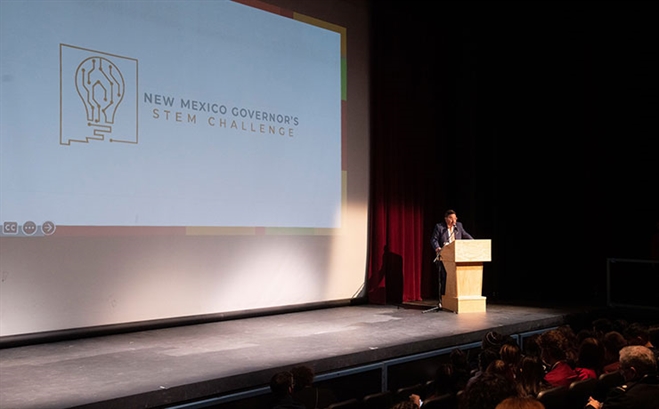New Mexico Governor’s STEM Challenge 2024
March 08, 2024 by Rhiannon Barber

Ryan Labbe, general manager of Tyler's New Mexico team, reflects on this year's New Mexico Governor's STEM Challenge, for which he served as steering committee chair, and shares goals for next year's event.
Five years ago, Bill McCamley, then-secretary of New Mexico's Department of Workforce Solutions, created the New Mexico Governor's STEM Challenge. Fostering a unique partnership between the public and private sectors, the purpose of the challenge is to cultivate the next generation of STEM leaders and innovators from New Mexico.
In January, more than 400 students from across New Mexico participated in the challenge. Each team of high schoolers was led by a teacher and supported by an expert mentor, and while the students had the opportunity to compete for financial prizes, corporate sponsors had the chance to advise and recruit STEM students.
This year, students were specifically challenged to have their projects respond to post-pandemic issues and community mental health challenges. Labbe, who oversees projects for Tyler New Mexico and chaired the 2024 steering committee, shares takeaways from this year's challenge along with its impact on students and the technology space in New Mexico.
How did you first get involved with the STEM Challenge?
I got involved [last year] for selfish reasons. I need programmers and engineers here and now. I went to the last showcase in Las Cruces, [and] that day in December 2022 changed my life. We had projects on issues like nuclear waste cleanup, food insecurity, and potable water. I have a great friend who’s a professor of youth psychology, and he taught me that young people are incredibly resilient, and it’s obvious with STEM scholars. These students weren’t beat down or maligned; they just saw a problem and did something about it. Just creating the space and opportunity for these students to solve community challenges with technology was incredible to see.
This was the first time in three years the STEM Challenge returned to a fully in-person format, and the first year with a steering committee, which you chaired. What was that experience like?
It was great for the students to be able to showcase their work and ideas to an in-person audience again. One of the big goals of the steering committee was recruitment — not just getting the kids psyched up about it, but getting teachers and administrators excited as well. If there is a group of students somewhere that wants to do this, but they can't find a teacher who will commit to leading their group, they can't do it. So that was and remains a big piece of the committee’s work. And then, you know, recruiting sponsors to support event costs, student awards, teacher stipends, and so on. This year, we grew participation by 100 students, so 400 total. And we increased our budget by about $100,000 this year as well.
This year, students were challenged to pitch projects relating to post-pandemic issues and community mental health challenges. Were there certain projects that stood out to you?
The project themes that appeared this year were heavy for lack of a better term: isolation, depression, addiction. You start talking to these kids and you realize how many students and families have been impacted by heartbreaking and adult realities. One difficult example: a team designed gunshot detection hardware. They built a functioning device that could detect and display the direction of gunfire. It’s difficult and heartbreaking to think about, but then you think that other districts across the country have spent tens of millions of dollars for similar commercial equipment in their schools.
Groups looked across the board though; projects addressed food insecurity, student anxiety at school, and thoughtfully designed, fun, engaging community spaces. It’s been an honor to see the compassion these kids have poured into their STEM projects that solve real problems.
What lies ahead for the STEM Challenge and Tyler's involvement?
I get one more year of serving as committee chair, and my goal next year is for us to raise $500,000 and recruit 500 students to participate. This was Tyler's second year supporting the event as a keynote sponsor, and the challenge really aligns with what Tyler does and strives for. Facilitating collaboration between the private and public sectors, improving and leveraging technology to better our world and communities — that's right at the heart of our mission.
Through these projects, we're very fortunate that we have this opportunity to get real insight into how this generation is thinking, what concerns them. And then we get to be inspired. There’s a lot of opportunity in New Mexico for technology and defense careers, and Tyler is excited to support the development of a new generation of technology leaders to address public and community issues.